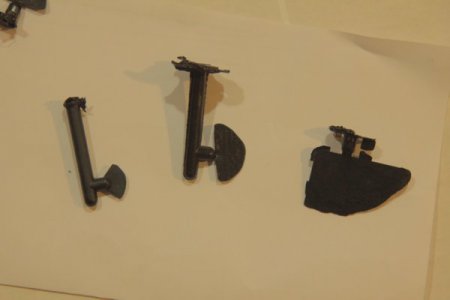- Joined
- Nov 18, 2012
- Messages
- 1,352
Stupid question, but do you have enough melt for the shot size?
I am wondering the same thing.
David
Stupid question, but do you have enough melt for the shot size?
Stupid question, but do you have enough melt for the shot size?
As an experiment, if you can pull the mold out easily, I'd throw it in an oven set to 400F, let it warm up and then put it back in the molder as quickly as you can and take a shot.
I'd extend the main runner at least another 1/4 to 3/8" in order to increase retained melt temperature at the transition to the gate runner.
While I don't think your issue stems from venting, I would probably gamble in this case and increase vent depth to .003" and make them a full 1/2" wide with at least 30% of parting line being vented. It looks like you have plenty of venting BUT those unvented corners are a red flag to me. I can see your flow trapping air in each of the four corners as the flow passes the edges of the nearest vents. If I received this as a new tool, it would be immediately disassembled and those corners vented before ever going out to the press.
If your fan gate isn't ramped, consider doing so. If it's only .022" deep across the full length of the gate, you're going to need significant pressure to drive the material through that narrow slot.
You are trying to force your material around a corner. Can you inject it straight in with a short sprue?
Thank you for all the advice ghostdncr. I currently have 1/4" wide vents taking up a little more than 30% of the parting line. I'll be modifying the mold today to have a tiny gate to see if that gives me the pressure I need. While I'm at it, I'll go ahead and add vents to the corners.
You mention increasing the depth to .003 - would that not cause flashing in the vents if the recommended vent depth is .002"? I'm quite new to all this, and vent tolerance is something I've been thinking about in the recent weeks.
I think you're spot on concerning the fan gate being too thin for a hand operated injection. If the small pin gate doesn't get me there, I'll likely go back to using the fan gate with a ramp as you've recommended.
View attachment 232550 I was thinking something more along these lines.
With the lower injection pressures you are surely running with your press, I suspect you can get away with a somewhat deeper vent than what's normally recommended. That is, IF my memory is correct on the production specs.
I agree with ghostdncer - you are trying to design your mold based on criteria for large presses.
I looked at the video they have for your press and they are injecting straight into the mold but its hard to say what the material is.
This is 100% due to injection pressure limitation. Pressure loss is proportinal to 1/t^3 with t being the thickness dimension of the fan or the card depending on where you are calculating the loss. Since you are getting through the gate, I suspect the main problem is the thickness of the card itself but opening the fan and gate thickness will help
ABS is an amorphous polymer which means the viscocity is less affected by injection rate but more affected by resin temp and mold temperature. Earlier, it was recomended that mold temp be raised. That was a very good recomendation.

